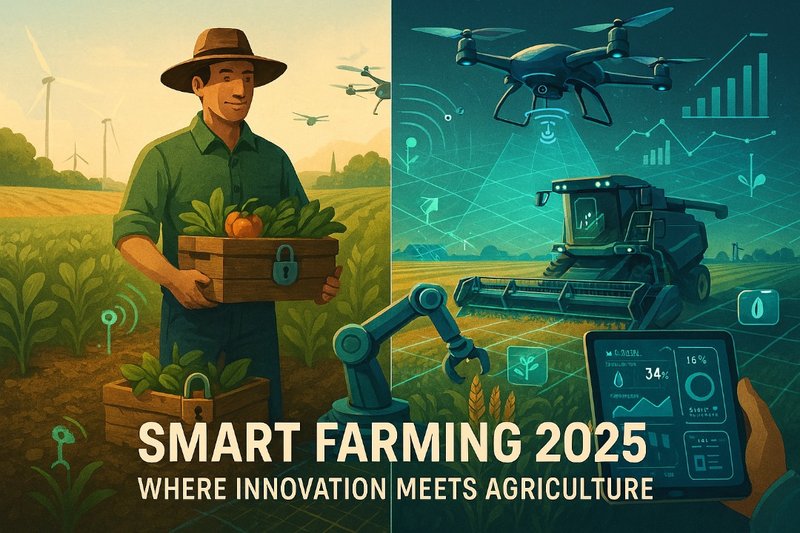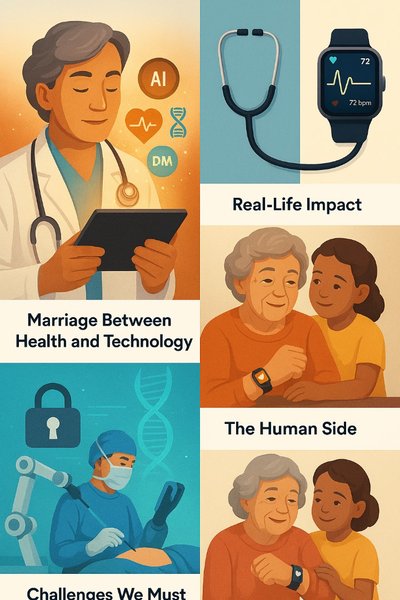In 2025, agriculture is no longer defined by tradition alone—it’s rapidly evolving through technology. Across continents, digital innovation is meeting the plough, drone is meeting soil, and data is becoming just as valuable as rainfall. Today’s farms are equipped not only with tractors, but with cloud dashboards, smart sensors, autonomous harvesters, and finance apps. From smallholders to large agribusinesses, technology is transforming how we grow, manage, and deliver food. This post explores the key innovations powering modern agriculture, combining traditional knowledge with cutting-edge digital tools.
Modern farms now integrate a wide ecosystem of tools—from automated combines and soil sensors to AI forecasting systems and blockchain contracts. These innovations are solving real challenges: labor shortages, unpredictable weather, food waste, and market access.
-
Artificial Intelligence and Machine Learning
AI tools are transforming farms into predictive, intelligent systems. Through satellite imagery, weather data, and past yield performance, AI models forecast planting schedules, harvest windows, and even pricing patterns.
AI platforms now provide:
-
Predictive crop modeling: determining when to plant based on rainfall forecasts and seed variety.
-
Smart irrigation planning: using historical and real-time weather to optimize water use.
-
Pest and disease identification: using camera vision and AI algorithms to detect early signs before human eyes can.
Combined with mobile apps, farmers in remote areas can receive AI recommendations via simple SMS alerts or dashboards in their preferred language.
-
Precision Farming with Drones and Satellite Mapping
Drones and satellites have brought aerial intelligence to the field. Equipped with infrared sensors and imaging cameras, drones fly over fields and collect precise data on crop health, moisture levels, and pest zones.
Applications include:
-
Monitoring crop maturity to guide harvest times.
-
Identifying underperforming sections of land.
-
Spraying fertilizers or pesticides only where needed—reducing chemical waste and costs.
Drones can cover hectares in minutes, offering weekly updates on field health and optimizing inputs in real time.
-
Combine Harvesters and Smart Equipment
Traditional tools are being reimagined. The modern combine harvester now includes GPS, moisture sensors, and yield monitors. These machines harvest with surgical accuracy, store data on productivity per square meter, and sync with cloud-based farm management systems.
Modern smart equipment includes:
-
GPS-guided tractors with automated steering and path correction.
-
Multi-functional seeders that adjust seed depth and spacing based on soil condition.
-
Planters with variable-rate technology that change fertilizer flow based on nutrient mapping.
These machines reduce overlap, conserve fuel, and improve field productivity while minimizing human error.
-
Internet of Things (IoT) and Smart Sensors
IoT sensors are small but powerful devices placed in soil, irrigation lines, or machinery. They monitor real-time conditions such as soil moisture, air humidity, pH levels, and equipment performance.
Use cases:
-
Soil moisture sensors triggering irrigation systems only when needed.
-
Temperature sensors in greenhouses adjusting ventilation automatically.
-
Livestock monitoring collars that track animal movement and health.
Connected to mobile devices or farm dashboards, these tools help farmers respond instantly to changing conditions and avoid waste.
-
Vertical Farming and Controlled Environments
With population growth and urban land pressure, farming is moving indoors. Vertical farming uses stacked layers, artificial lighting, and hydroponic or aeroponic systems to grow food in controlled environments.
Advantages include:
-
Year-round production unaffected by external climate.
-
90% less water use compared to traditional farming.
-
Zero pesticides due to enclosed environments.
Urban buildings are being repurposed into high-tech farms producing leafy greens, herbs, and even strawberries with LED lighting and nutrient-rich water systems.
-
Climate-Smart and Regenerative Agriculture
Modern agriculture must also respond to environmental challenges. Climate-smart farming integrates techniques that reduce carbon emissions, preserve biodiversity, and improve soil health.
These include:
-
Crop rotation and intercropping to restore soil nutrients.
-
Cover cropping to prevent erosion and water loss.
-
Biochar use to sequester carbon in soil.
Regenerative practices also open up income through carbon credit programs. Farmers who adopt sustainable practices can earn additional income by selling verified environmental benefits to companies offsetting emissions.
-
Blockchain and Agri-Fintech
Tech is modernizing the business side of agriculture too. Blockchain enables transparent tracking of food from farm to table. Consumers can scan a product and trace its source, and farmers gain credibility and better pricing.
Digital platforms now offer:
-
Mobile loan applications tailored to seasonal cycles.
-
Instant digital payments through smart contracts.
-
Microinsurance plans based on weather or yield outcomes.
This financial inclusion helps farmers secure tools, seeds, and services without relying on inconsistent local lenders.
-
Robotics and Autonomous Systems
Beyond tractors, robotics is reshaping manual farm labor. Autonomous machines now plant, prune, pick, and pack—saving time and reducing dependence on seasonal labor.
Popular examples:
-
Apple-picking robots with vision systems identifying ripeness.
-
Lettuce harvesters that cut and pack with speed and consistency.
-
Weeding robots using AI to identify and remove unwanted plants without disturbing crops.
These robots work day and night, increasing efficiency without fatigue or error.
-
Agrivoltaics and Renewable Energy Integration
Farms are now energy producers too. Agrivoltaic systems combine solar panels with crop cultivation—allowing the same land to generate food and electricity. This dual-use model increases farm revenue and energy independence.
Solar-powered irrigation pumps and greenhouse lighting reduce operational costs and emissions, especially in off-grid areas. Biogas systems using crop waste further help farms recycle and reduce environmental footprint.
-
Big Data and Digital Twin Models
Farm management is becoming data-driven. Big data platforms integrate all information from sensors, weather services, equipment, and sales to create a full picture of farm performance.
Digital twin models simulate farms virtually, allowing farmers to test scenarios—like adjusting irrigation or fertilizer timing—before applying them on the field. This reduces risks, improves outcomes, and supports better planning.
By 2025, even small farms can access these tools through mobile platforms or partnerships with agritech firms and NGOs.
These innovations are building a future where farming is not just productive—but intelligent, sustainable, and resilient. Whether it’s a cocoa farm in West Africa, a rice paddy in Southeast Asia, or a vertical farm in New York, the digital age of agriculture is here—and it’s growing.
💬 Join the Discussion:
With all these technologies transforming the future of farming, do you think traditional farming methods still have a strong place in today’s world?
📌 Should farmers prioritize adopting digital tools, or is there still value in keeping some parts of farming manual and organic?
Drop your thoughts below — whether you're a farmer, tech enthusiast, entrepreneur, or consumer, your voice matters in shaping the future of agriculture.




Comments (0)
Leave a Comment
No comments yet. Be the first to comment!